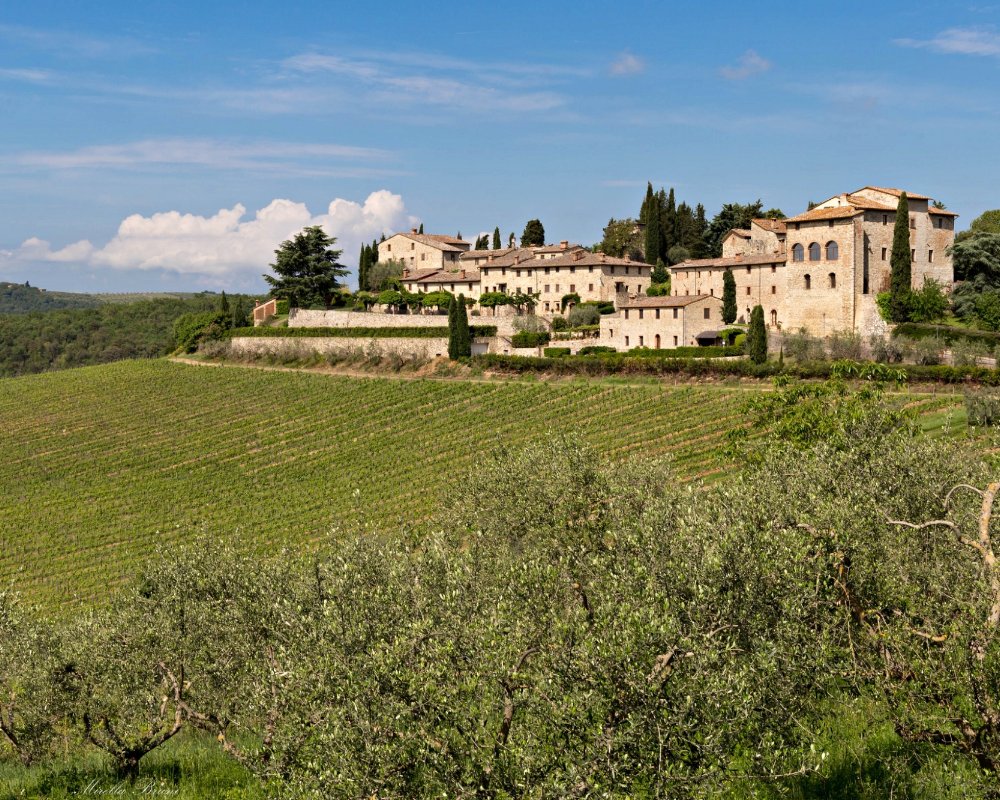An itinerary for admiring spectacular castles surrounded by vineyards
Chianti is a historic wine-producing region famous throughout the world and, thanks to its timeless wines, it has become an ambassador for the most classic side of Tuscany. To discover the area, you can head into this sea of hills and be led by the rows of grape vines that, like waves, take you from one treasure to another. Follow this itinerary to explore a territory where wine is just one of the many splendid attractions.
Our journey begins at the Castle of Lucignano, in the municipality of Gaiole in Chianti. Evidence dating back to Etruscan and Roman times tells us that the area was already inhabited in antiquity. The building unquestionably already existed around the year 1100, as shown by documents discovered in Coltibuono. The Ricasoli Barons transformed it into an agricultural estate and, still today, the Sangiovese grape vines around the castle are used to make Chianti Classico DOCG.
Our journey begins at the Castle of Lucignano, in the municipality of Gaiole in Chianti. Evidence dating back to Etruscan and Roman times tells us that the area was already inhabited in antiquity. The building unquestionably already existed around the year 1100, as shown by documents discovered in Coltibuono. The Ricasoli Barons transformed it into an agricultural estate and, still today, the Sangiovese grape vines around the castle are used to make Chianti Classico DOCG.
Heading to our next destination, Lucignano accompanies us a little further, on our right, with a view of its vineyards. The road to San Giusto a Rentennano is just beyond, on the right; simply walk along the tree-lined avenue to get to the Fattoria. Built over a medieval monastery, it was later transformed into a fortress and is currently surrounded by more than 150 hectares of land. These fields are used to produce the typical wine, but also vin santo and olive oil.
Heading to our next destination, Lucignano accompanies us a little further, on our right, with a view of its vineyards. The road to San Giusto a Rentennano is just beyond, on the right; simply walk along the tree-lined avenue to get to the Fattoria. Built over a medieval monastery, it was later transformed into a fortress and is currently surrounded by more than 150 hectares of land. These fields are used to produce the typical wine, but also vin santo and olive oil.
Following a stretch of the Arbia river, we cross an expanse of vineyards until we reach the fork for Tornano. The medieval castle is totally immersed in the forest and is an oasis of peace where you can taste the farm’s products.
Following a stretch of the Arbia river, we cross an expanse of vineyards until we reach the fork for Tornano. The medieval castle is totally immersed in the forest and is an oasis of peace where you can taste the farm’s products.
Returning to the main road, you can choose to climb towards the little village of Lecchi, home to the Castle of Monteluco. Originally a fortification, it still retains part of its ancient walls and an old defense tower. From here, you can continue on to the next destination, with the Chianti countryside as the backdrop to our adventure through unique villages.
Returning to the main road, you can choose to climb towards the little village of Lecchi, home to the Castle of Monteluco. Originally a fortification, it still retains part of its ancient walls and an old defense tower. From here, you can continue on to the next destination, with the Chianti countryside as the backdrop to our adventure through unique villages.
The splendid Castle of Ama was mentioned for the first time in the 13th century, even though the Etruscans had also been drawn towards this area. The village is a collection of historic villas, churches and very characteristic houses that create a fairy-tale atmosphere. The winery is also famous for having established a contemporary art park on its property.
The splendid Castle of Ama was mentioned for the first time in the 13th century, even though the Etruscans had also been drawn towards this area. The village is a collection of historic villas, churches and very characteristic houses that create a fairy-tale atmosphere. The winery is also famous for having established a contemporary art park on its property.
Our itinerary is coming to a close and there’s no better place to end than the Castle of San Polo in Rosso, a fascinating medieval village that was long fought over by Florence and Siena before being owned for a long period by the Ricasoli family. Located at an altitude of 500 meters, the castle is in a privileged position for admiring the hilly landscape below and taking in the full essence of Chianti.
Our itinerary is coming to a close and there’s no better place to end than the Castle of San Polo in Rosso, a fascinating medieval village that was long fought over by Florence and Siena before being owned for a long period by the Ricasoli family. Located at an altitude of 500 meters, the castle is in a privileged position for admiring the hilly landscape below and taking in the full essence of Chianti.


